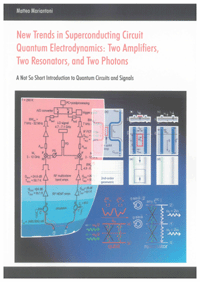
Shop : Details
Shop
Details

November 2010
Matteo Mariantoni
New Trends in Superconducting Circuit Quantum Electrodynamics: Two Amplifiers, Two Resonators, and Two Photons
A Not So Short Introduction to Quantum Circuits and Signals
Superconducting quantum circuits, together with trapped ions, are considered one of the most viable venues for the experimental implementation of quantum computing and quantum simulations. The study of quantum circuits also allows us to gain a deeper comprehension of a variety of quantum phenomena ranging from the foundations of quantum measurement to multi-partite entanglement.
Circuit quantum electrodynamics (QED), which studies the interaction of superconducting quantum bits (qubits) based on Josephson junctions with on-chip microwave resonators, represents one of the richest sub-disciplines of the superconducting quantum circuit realm. In this framework, our work constitutes a significant extension of the so far developed circuit QED architectures, both theoretically and experimentally. As suggested by the title, we have shifted the center of mass of existing circuit QED settings from "one" to "two" in three different ways. First, we have shown that the use of a cross-correlation measurement setup based on two independent amplification chains makes possible to unveil the fundamental properties of quantum microwave devices. In particular, we have experimentally shown that even seemingly three-port microwave beam splitters effectively behave as four port quantum devices. Second, we have developed the theory of two-resonator circuit QED, where two independent microwave resonators can interact depending on the state of a superconducting qubits off-resonantly coupled to both of them. Our theory stands at the basis of novel quantum computing and quantum simulation architectures and indicates the path towards the entanglement of delocalized bosonic modes. Third, we have demonstrated that the two-photon coherent driving of a qubit coupled to a harmonic oscillator makes possible to explore the selection rules and symmetry properties of "artificial atoms." We notice that this work is also intended as a not so short introduction to the mathematical formalism at the basis of microwave quantum circuits and signals. Most of the derivations and tools developed in this thesis, and which are not published elsewhere, are meant to provide a useful reference manual for the circuit QED user.Keywords: superconducting qubits; circuit quantum electrodynamics; quantum microwaves; quantum computing; circuit QED; Planck distribution; microwave beam splitters; two-resonator architectures; selection rules; symmetry breaking
Available online documents for this title
You need Adobe Reader, to view these files. Here you will find a little help and information for downloading the PDF files.
Please note that the online documents cannot be printed or edited.
Please also see further information at: Help and Information.
Please also see further information at: Help and Information.
| Document |  | Abstract | ||
| Type |  | |||
| Costs |  | free | ||
| Action |  | Download the file | ||
| Document |  | Document | ||
| Type |  | |||
| Costs |  | 37,35 € | ||
| Action |  | Purchase in obligation and download the file | ||
| Document |  | Table of contents | ||
| Type |  | |||
| Costs |  | free | ||
| Action |  | Download the file | ||
User settings for registered online customers (online documents)
You can change your address details here and access documents you have already ordered.
User
Not logged in
Export of bibliographic data
Shaker Verlag GmbH
Am Langen Graben 15a
52353 Düren
Germany
Am Langen Graben 15a
52353 Düren
Germany
Mon. - Thurs. 8:00 a.m. to 4:00 p.m.
Fri. 8:00 a.m. to 3:00 p.m.
Fri. 8:00 a.m. to 3:00 p.m.
Contact us. We will be happy to help you.

